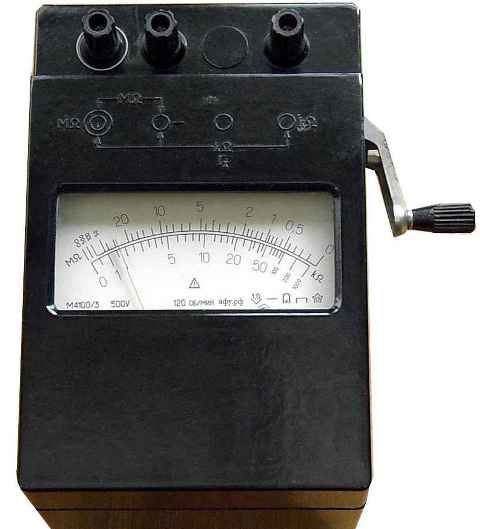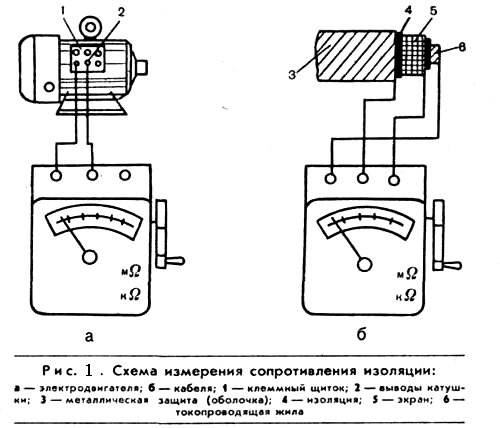Measurement of DC insulation resistance
DC insulation resistance is the main indicator of the insulation condition, and its measurement is an integral part of testing all types of electrical equipment and electrical circuits.
Standards for inspections and tests of insulation of electrical equipment are determined by GOST, PUE and other directives.
Insulation resistance is measured in almost all cases by a megohmmeter - a device consisting of a voltage source - a direct current generator, most often with a manual drive, a magnetoelectric ratio and additional resistances.
In electromechanical devices, the power source is an electromagnetic bus generator driven in rotation by a handle; the measuring system is made in the form of a magnetoelectric ratiometer.
In other types of megometers, a voltmeter is used as the measuring element, which records the voltage drop across the reference resistor from the current in the measured resistance.The measuring system of electronic megometers is based on two operational amplifiers with a logarithmic characteristic, the output current of one of which is determined by the current of the object, and the other by the voltage drop across it.
The measuring device is connected to the difference of these currents, and the scale is carried out on a logarithmic scale, which makes it possible to calibrate it in units of resistance. The result of the megohmmeter measurement of all these systems is practically independent of the voltage. However, in some cases (insulation test, absorption coefficient measurement) it should be taken into account that with low insulation resistances the voltage at the terminals of the megohmmeter can be significantly lower than the nominal voltage due to the high resistance of the limiting resistor , which serves to protect the power supply from overload.

The output resistance of the megohmmeter and the true value of the object voltage can be calculated, knowing the short-circuit current of the device, in particular: 0.5 for megohmmeters of the F4102 type; 1.0 — for F4108 and 0.3 mA — for ES0202.
Since there is a direct current source in megohmmeters, the insulation resistance can be measured at a significant voltage (2500 V in megohm meters of types MS-05, M4100 / 5 and F4100) and for some types of electrical equipment simultaneously test the insulation with increased tension. However, it should be borne in mind that when the megohmmeter is connected to a device with reduced insulation resistance, the voltage at the terminals of the megger also decreases.
Measurement of insulation resistance with a megohmmeter
Before starting the measurements, make sure that there is no voltage on the test object, clean the insulation well from dust and dirt, and ground the object for 2 - 3 minutes to remove possible residual charges from it. Measurements must be made with a stable position of the instrument arrow. To do this, you need to quickly but evenly turn the handle of the generator. The resistance of the insulation is determined by the arrow of the megohmmeter. After the measurements are completed, the test object must be emptied. To connect the megohmmeter to the device or line under test, use separate wires with high insulation resistance (usually at least 100 MΩ).
Before using the megohmmeter, it must undergo a control check, which consists of checking the scale readings with open and shorted wires. In the first case, the arrow must be on the scale of "infinity", in the second - at zero.
In order not to affect the readings of the megohmmeter by the leakage currents on the insulating surface, especially when measuring in wet weather, the megohmmeter is connected to the measured object using the E clamp (screen) of the megohmmeter. In such a measurement scheme, the leakage currents on the insulation surface are diverted to ground, bypassing the ratio winding.
The value of the insulation resistance is highly dependent on temperature... The insulation resistance must be measured at an insulation temperature not lower than + 5 ° C, except for cases specified in special instructions.At lower temperatures, the measurement results, due to the unstable state of moisture, do not reflect the true characteristics of the insulation.
In some DC installations (batteries, DC generators, etc.) the insulation can be monitored with a voltmeter with high internal resistance (30,000 — 50,000 Ohms). In this case, three voltages are measured — between the poles (U) and between each pole and ground.

